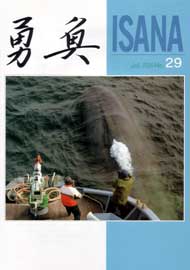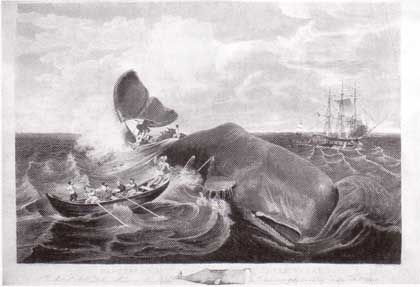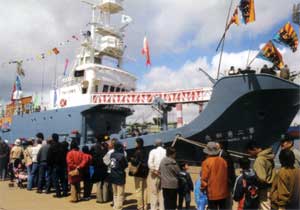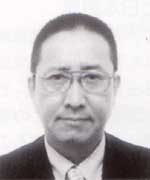ISANA Jul. 2004 No.29
index

ISANA Jul. 2004 No.29
American whaling and the Japanese Archipelago
Scale of American whaling
American sailing-vessel whaling saw its prime days from 1840 to 1860. It was a time when Japan was surprised by the U.S. demand to open its gate to the world. In its peak period, American whaling had become a global scale industry, developing whaling grounds in all of the oceans of the world, except the Antarctic. In hunting or fishing industries, up to the present time, there has been no case in which a single animal was hunted so extensively. In this sense, American whaling was an industry of historic stature.
It boasted an enormous scale at its peak, with more than 700 whaling boats throughout the United States. As the number of crew in an average 30-ton-class ship-type vessel was about 30, 15,000 to 20,000 people were engaged in whaling operations on the sea. In the 1840s, more than half of the vessel headed for the Pacific, and a majority of them operated in the north Pacific. Therefore, around 10,000 people might have been mobilized in the area near the Japanese Archipelago. When workers on land were included, the industry as a whole employed approximately 70,000.
The number of the whales caught was also overwhelming. Tentative statistics released in 1878 showed that about 410,000 whales--about 220,000 sperm whales and about 190,000 right whales--were hunted during the 72 years from 1804 to 1876. At that time, a diversity of whaling was conducted throughout the world, but the American whaling occupied an unmatched proportion of over 80% of the overall global hunt. Furthermore, in operations other than American-type whaling, specific whales were caught all the year round, and "harvesting-type" operations had been conducted on the assumption of reproduction of the resources. By contrast, American whaling alone adopted "mining-type" operations without regard to reproduction of the resources.
Toward the Pacific
Initially in the 17th century, American whaling was a small operation along the coast, but gradually made advances into the oceans of the world. In the 18th century, sperm whale whaling started in addition to the hunt of right whales. In the meantime, as a result of focusing on these two species, American whaling came to face the risk of overexploitation, and countered this problem with the strategy of "development of new whaling grounds.
" It took a century for American whaling to dominate the north Pacific after it left New England early in the 18th century. However, after it entered the southern Atlantic beyond the equator in the 1770s, it reached Cape Horn in only 10 years, and advanced from Cape Horn into the Pacific at the end of the 18th century. The vessels, which sailed around Cape Horn, moved northward along the coast of the South American continent and proceeded westward along the equator toward the Pacific.
Galapagos Islands, situated at the mouth of the whaling grounds, became sperm whaling grounds in the 1810s. Galapagos later became the supply base for whaling vessels, and Galapagos turtles (which now are placed under strict protection) were overexploited as fresh meat that could be preserved alive on board. From Galapagos, "offshore grounds" and "on-the-line grounds" of a vast sperm whales whaling ground ranged along the equator. In the 1820s, the "Japan Ground"--the whaling ground surrounding the Ogasawara Islands and the Japanese Archipelago was developed. In subsequent years, development of whaling grounds, depletion of the resources and development of new whaling grounds occurred alternately. Development of whaling grounds continued to the Okhotsk Sea, the Bering Sea and the Arctic Sea until American whaling began declining.
Japan Grounds
The historically famous "Japan Ground" is the whaling ground extending to the north Pacific where only sperm whales were targeted. The exploration records of the time show that the ground covered the area from 25 degrees N. to 40 degrees N. and 125 degrees E to 150 degrees E. At times, it included the Korean Peninsula and the Sea of Japan. The name of the whaling ground was derived from the fact that "Japan," which had closed its gates to the outer world at that time, was situated to the northwest of this whaling ground.
The whaling vessels either used the Bonin Islands (now Ogasawara Islands) as a refueling base or sailed directly back to Hawaii after hunting without refueling during the whaling season. The logbooks of whaling vessels then recorded in many cases "off Bonin" (off the Ogasawara Islands) or "on Japan" (in the Japanese whaling ground). Operation of only several vessels were confirmed from 1819 to 1821, but in 1822, more than 20 ships sailed toward the "Japan Ground", then increased to about 100 vessels a year in the peak period of the 1840s.
The new whaling ground also gave momentum to scientific research in the Pacific. From the 1820s, scientific research vessels not only of the United States but of other countries collected information on the area in the interest of whaling, trade and military activities. The information collected, coupled with that from whaling ships, was analyzed, and the usefulness of this area to the United States and the European countries was "discovered." For example, whaling grounds throughout the world were listed in the whaling charts developed in 1851 by the U.S. Navy enabling identification of the optimum whale species in the optimum area throughout the year as well as the design of whaling cruise routes. In the area around the Japanese Archipelago, on whose coast lines whaling groups engaged in the traditional hunting, many symbols of sperm whales and right whales had been described.
Japan Ground and the Japanese Archipelago
Charles Wilkes of the U.S. Navy carried out large-scale research activities in the Pacific from 1838 to 1842, and presented voluminous reports in 1845. Regarding the contact with the "native people" in the Pacific, Wilkes recommended, in his reports, to deal with them with justice and sincerity. This would help Americans to avoid "betrayal" of the "native people" and they in turn could benefit from the American civilization. For Wilkes, the "superiority" of the Americans was evident and the native people were understood as those who would receive benefits from Americans.
Following the discovery of the "Japan Ground," local communities in the Japanese Archipelago, the Korean Peninsula, Aleutian Islands, Kuril Islands, Siberia, Kamtchatska and Alaska began contact with the Americans. It was not a simple experience in which a superior culture destroyed local culture and the region was Americanized. What was actually happening was a complex and diverse conflict between America and local cultures. In recent studies, the image of "passive native people" is being discarded but light has been shed on the fact that the local communities coped with the situation subjectively, using diverse strategies and tactics, and making it an energy to form a new culture. The Japanese Archipelago was one of the "islands" that became involved in this conflict, and the advance of American whaling into the "Japan Ground" prompted the people to join this process.

About Whales
Ordinarily, I am engaged in work related to cooking.
My daily routines are writing for magazines and participating in TV cooking programs, presenting dishes using seasonal vegetables and simple cooking that can be done by children. I cut vegetables, boil fish, and cook meat in a frying pan. My job forces me to stand in the kitchen every day, and, thanks for that, my legs, arms and body grew quite muscular.
Probably because of my avid interest in dietary matters, I was invited to join in the first symposium on whales sponsored by the Group to Preserve Whale Dietary Culture. I felt somewhat strained because there I was a mere panelist, sitting in front of a table without a carving knife or a chopping board. But I was happy to have learned many things about whales of which I had very little knowledge. The presentations made at the symposium were very interesting to me. And, of course, I renewed my knowledge that whale dishes are really palatable.
The conclusion I drew from the symposium was: "Let's eat whales."
I wish to say with confidence that eating tasty whale meat with much care is part of the Japanese culture. I think the people who do not have a habit of eating some particular food--for example, dried horse mackerel or dried sardine or salted fish guts--are not in a position to intrude into the food habits of other people who do so. Of course, I am ready to lend my ears to any criticisms and try to understand. But as I try harder to understand, I began to find too adamant the minds of those who oppose. I simply don't understand why it is good to eat cattle, sheep, pigs, deer and rabbits and not whales.
Here I jump to another topic. A certain Mr. Suzuki with whom I became acquainted through my job, said to me that he doesn't feel well if he sees his children leave vermiculated anglefish on their dishes.
He said: "It cannot be helped if children can't finish a voluminous amount of fish meat. But anglefish, no matter how small it is, is one whole living creature. I am led to think what was the meaning of this tiny fish coming into the world when I see it left over in the midst of grated radish. I think the purpose of its life is well served when man eats it all with satisfaction." Japanese adages say that life is a valuable thing or that even a tiny insect has its small soul. I think it is in a sense a part of our culture to care also for tiny creatures."
Mr. Suzuki related his experience about whales as follows.
"I was born in 1959. This memory goes back to the days when I was a first or second grader in elementary school (of course my mother says it was when I was in kindergarten.)"
"Oshika Peninsula is in Miyagi Prefecture, northern Japan. You can go there by taking a local train from Sendai to Ishinomaki and then from there take a five-to-six-hour ride by bus. Ayukawa is a whaling town in that peninsula. My mother's relatives lived there, running a public bathhouse, a restaurant and a bar. I could feel the whole town become activated when whales were landed. The bar owned by my relatives had a slight rough atmosphere with crews of whaling boats as customers, who are not like more elegant sailors you find in large port cities like Yokohama."
"The bar prospered when whales were landed because the crews of whaling boats squandered their money. On the eve of the whale landing day, I heard people talking 'Tomorrow whales will be landed' with anticipation and expectation that they will become busy. Just to add, my aunt had a talent for entertaining, which she acquired when she moved to Ayukawa during war time."
"A variety of whales were caught: sperm, fin, pilot, minke... Big whaling boats towed some whales when they came back to the port. Each whale was the same size as the boat or larger. All the townfolk went to the port to welcome the coming back of the boats. The whales were taken to the flensing station."
"A number of flensing workers with large flensing knives in their hands mounted the back of the whale and started cutting it up. I heard a crumping sound as the flensing proceeded. Streams of blood flew around and along the waterway, which went into the sea. The sea all around changed to red. It was a striking sight."
"As a child, I was sent to the flensing site with a bucket to receive some whale meat. The meat was cut into 30-meter square blocks. As the whale was so huge, the whaling company could give out as much as the people wanted. When whales were landed, the town's economy went up. The whale was the foundation of the town and the symbol of vitality. But whaling in Ayukawa gradually declined, and along with it, the town itself lost its vigor. It was as though the town itself disappeared. In the end, almost all the townsfolk, including my relatives, moved to Ishinomaki, a larger fishing town in the prefecture."
I asked Mr. Suzuki how they cooked whales, and he phoned his 76-year-old mother. He repeated to me what she was saying: "First of all, we ate whalemeat raw with soy sauce and grated horseradish. We used horseradish, and not ginger, because the meat was so fresh. The whale was in a prime condition. The best part was the tail meat. I had tasted no better meat than that. Prime tuna was no comparison. We also made whale steaks and also kept it in soybean paste or broiled and ate it with salt, pepper and lemon. We also cooked the meat in a pot with vegetables. Blubber, the part between the skin and the meat, in thickness of about 30cm, was made into bacon or cooked with vegetables and devil's tongue in a piece about 2cm. At times we cooked it with soy sauce or soybean paste. Devil's tongue was a must. It always accompanied whale blubber. We also salted some meat and roasted it quickly and served it as relish to be eaten with sake. What impressed me most was flensing. I was watching the work and tried to find out the best part I wanted to receive."
Hearing this, I felt a joy in my heart although it was not my own experience. I thought it was because the memory of whale is deeply woven into the fabric of my DNA as a Japanese.
So, let's eat whales with gratitude.

Symposium on whale and dietary culture(Feb. 17,2004)



